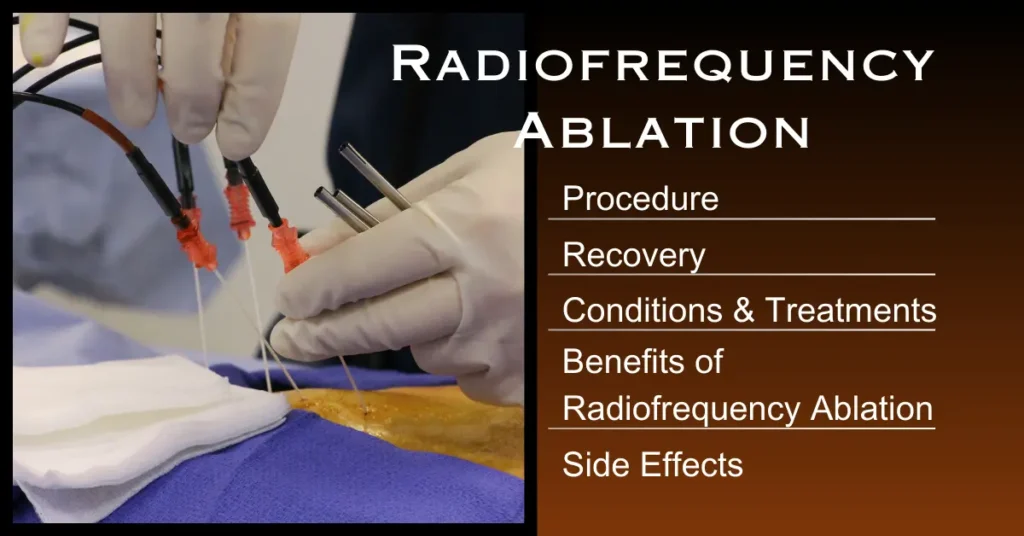
Introduction:
In the realm of modern medicine, radiofrequency ablation (RFA) has emerged as a revolutionary technique for treating various medical conditions. This minimally invasive procedure utilizes heat generated from radiofrequency energy to target and destroy abnormal tissue, offering patients an alternative to traditional surgery.
In this comprehensive guide, we explore the procedure and recovery process of radiofrequency ablation, along with its applications in treating different medical conditions.
Table of Contents
Procedure:
Radiofrequency ablation is typically performed in a specialized medical setting, such as a hospital or outpatient clinic, by trained healthcare professionals.
The procedure involves the following steps:
- Preparation: Before the procedure, patients undergo a thorough evaluation, including a medical history review and imaging studies to identify the target area. Local anesthesia or sedation may be administered to ensure patient comfort during the procedure.
- Guided Imaging: Using advanced imaging techniques such as ultrasound, computed tomography (CT), or fluoroscopy, the healthcare provider precisely locates the target tissue or tumor.
- Insertion of Probe: A small needle-like probe, equipped with electrodes, is inserted through the skin and positioned within or adjacent to the target area under image guidance.
- Radiofrequency Energy Application: Once the probe is in the desired location, radiofrequency energy is delivered through the electrodes to generate heat. The heat destroys the targeted tissue while minimizing damage to the surrounding healthy tissue.
- Monitoring and Adjustment: Throughout the procedure, the healthcare provider monitors the temperature and efficacy of the ablation using imaging guidance. Adjustments may be made as needed to ensure complete treatment of the target area.
- Completion: Once the ablation is complete, the probe is removed, and the insertion site is typically covered with a small bandage. Patients are then monitored for a brief period before being discharged home.
Recovery:
The recovery process following radiofrequency ablation is generally well-tolerated, with minimal discomfort and a short recovery period. However, individual experiences may vary depending on the specific condition treated and the patient’s overall health.
Key aspects of the recovery process include:
- Post-Procedure Monitoring: Patients are typically observed for a short period following the procedure to monitor vital signs and assess for any immediate complications.
- Discomfort Management: Some patients may experience mild discomfort, bruising, or swelling at the site of the ablation. Over-the-counter pain medications or prescribed pain relievers may be recommended to alleviate any discomfort.
- Activity Restrictions: While recovery times may vary, most patients can resume normal activities within a few days following the procedure. However, strenuous activities or heavy lifting may be restricted for a short period to allow for optimal healing.
- Follow-Up Care: Patients will typically have a follow-up appointment with their healthcare provider to assess treatment efficacy and address any concerns or questions. Additional imaging studies may be performed to evaluate the response to treatment.
Conditions & Treatments:
Radiofrequency ablation is used to treat a wide range of medical conditions, including:
- Liver Tumors: RFA is commonly used to treat primary liver tumors, such as hepatocellular carcinoma (HCC), as well as liver metastases from other primary cancers.
- Kidney Tumors: RFA may be employed to treat small renal tumors, particularly in patients who are not candidates for surgery or prefer a minimally invasive approach.
- Bone Tumors: RFA can be used to alleviate pain and improve the quality of life in patients with painful bone tumors, such as osteoid osteomas or metastatic bone lesions.
- Lung Tumors: RFA may be utilized to treat small lung tumors or metastases, particularly in patients who are not surgical candidates or have limited treatment options.
- Cardiac Arrhythmias: In the field of cardiology, RFA is used to treat certain cardiac arrhythmias, such as atrial fibrillation, by ablating abnormal electrical pathways in the heart.
Benefits of Radiofrequency Ablation:
Radiofrequency ablation offers several benefits, including:
- Minimally Invasive: RFA is a minimally invasive procedure that requires only small incisions, resulting in less trauma to surrounding tissues and faster recovery compared to traditional surgery.
- Pain Relief: RFA can provide effective pain relief for patients with various conditions, including cancer-related pain and chronic pain from conditions such as osteoarthritis.
- Shorter Recovery Time: Patients undergoing RFA typically experience a shorter recovery time compared to surgical interventions, allowing them to return to normal activities sooner.
- Targeted Tissue Destruction: RFA precisely targets and destroys abnormal tissue while sparing surrounding healthy tissue, minimizing the risk of complications and preserving organ function.
- Outpatient Procedure: In many cases, RFA can be performed on an outpatient basis, eliminating the need for overnight hospital stays and reducing healthcare costs.
Side Effects:
While radiofrequency ablation is generally considered safe and well-tolerated, some potential side effects may occur, including:
Pain or discomfort: Patients may experience mild pain or discomfort at the site of the ablation, which can typically be managed with over-the-counter pain medications.
Skin Irritation: Some patients may develop skin irritation or redness at the insertion site of the probe, which usually resolves within a few days.
Bleeding or infection: In rare cases, there may be a risk of bleeding or infection at the insertion site. Patients are typically monitored closely for any signs of complications and provided with appropriate care if needed.
Damage to Surrounding Tissues: While efforts are made to minimize damage to surrounding healthy tissue, there is a small risk of injury to nearby structures during the ablation procedure.
Rare Complications: Rarely, more serious complications such as blood vessel injury, nerve damage, or organ perforation may occur. Healthcare providers take precautions to minimize these risks and closely monitor patients during and after the procedure.
Commonly Asked Questions about Radiofrequency Ablation
Radiofrequency ablation is a minimally invasive procedure used to treat various medical conditions, including certain types of cancer and chronic pain. It works by delivering high-frequency electrical currents through a needle-like probe to heat and destroy abnormal tissue.
Radiofrequency ablation is commonly used to treat liver cancer, lung cancer, kidney cancer, bone metastases, and chronic pain conditions such as osteoarthritis and spinal pain.
Yes, radiofrequency ablation is generally considered safe when performed by experienced healthcare professionals. Like any medical procedure, it carries some risks, including bleeding, infection, and damage to surrounding tissues.
Recovery time varies depending on the specific condition being treated and the location of the procedure. In general, most patients can resume normal activities within a few days to a week after radiofrequency ablation.
Common side effects of radiofrequency ablation may include pain or discomfort at the treatment site, bruising, and swelling. In some cases, more serious complications, such as infection or nerve damage, may occur, although these are rare.
Radiofrequency ablation is highly effective in treating certain types of cancer, particularly small tumors or metastases. It can provide long-term tumor control and symptom relief with minimal side effects.
Candidates for radiofrequency ablation are typically individuals with small tumors or lesions that are located in accessible areas of the body. Your healthcare provider will evaluate your specific case to determine if RFA is an appropriate treatment option for you.
In many cases, radiofrequency ablation can improve overall survival rates for patients with cancer by effectively treating tumors and preventing disease progression. However, outcomes may vary depending on factors such as tumor size, location, and underlying health conditions.
Yes, there are several alternative treatments available, including surgery, chemotherapy, radiation therapy, cryoablation, and nerve blocks. The choice of treatment depends on factors such as the type and stage of cancer, as well as patient preferences and overall health.
During the procedure, you will receive local anesthesia or sedation to keep you comfortable. A thin needle-like probe will be inserted into the targeted tissue under imaging guidance, and radiofrequency energy will be delivered to heat and destroy the abnormal tissue. The procedure typically takes about 30 minutes to an hour, depending on the size and location of the lesion being treated.



